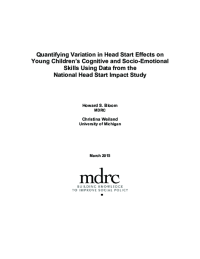Quantifying Variation in Head Start Effects on Young Children’s Cognitive and Socio-Emotional Skills Using Data from the National Head Start Impact Study
This paper uses data from the Head Start Impact Study (HSIS), a nationally representative multisite randomized trial, to provide a comprehensive analysis of variation in Head Start effects across individual children, policy-relevant subgroups of children, and Head Start centers. Although for decades researchers have studied the average effects of Head Start and its effects for selected socio-demographic subgroups, this is one of the first rigorous examinations of the nature, magnitude, and patterns of variation in program effects. As suspected by many, past estimates of the average effect of Head Start programs mask a wide range of relative program effectiveness.
In particular, this study finds that:
-
Head Start produced a “compensatory” pattern of effects that increase cognitive outcomes most for children with the weakest initial cognitive skills. This tends to equalize cognitive skills across program participants.
-
Head Start increased cognitive outcomes by far more for dual language learners and Spanish-speaking children (two highly overlapping subgroups) than for other children.
-
Unpacking the preceding findings reveals that much of the program’s effect on cognitive outcomes represents “compensation” for limited prior English. Although the effect of the program diminished over time, for children with limited prior English, it appears to persist for at least three years, when those children were in kindergarten or first grade.
-
The Head Start “treatment contrast” (differences between key features of individual Head Start programs and their local alternatives, including parent care) varies substantially across Head Start centers reflecting the fact that the “value added” by any Head Start program depends on both the program itself and the quantity and quality of other local options for early child education. For example, there was substantial variation in the treatment contrast with respect to hours of care, teacher education, and classroom quality.
-
Likewise, Head Start effects on cognitive and socio-emotional outcomes relative to those of local alternatives vary substantially across Head Start centers. Some Head Start centers are much more effective than their alternatives, while others are much less effective than their alternatives, with a broad range of centers operating between these extremes.
These findings suggest that: (1) much might be learned from identifying and studying especially effective Head Start centers, (2) much might be gained from encouraging Head Start participation by dual language learners and Spanish-speaking children who historically have been under-enrolled in the program, and (3) rigorous future research on factors that explain variation in Head Start effects might provide important guidance for improving the program, as well as improving other early child education programs. In addition, the methods used to study program variation in this paper can serve as a model for future studies of variation in the effects of other important social and educational interventions.






